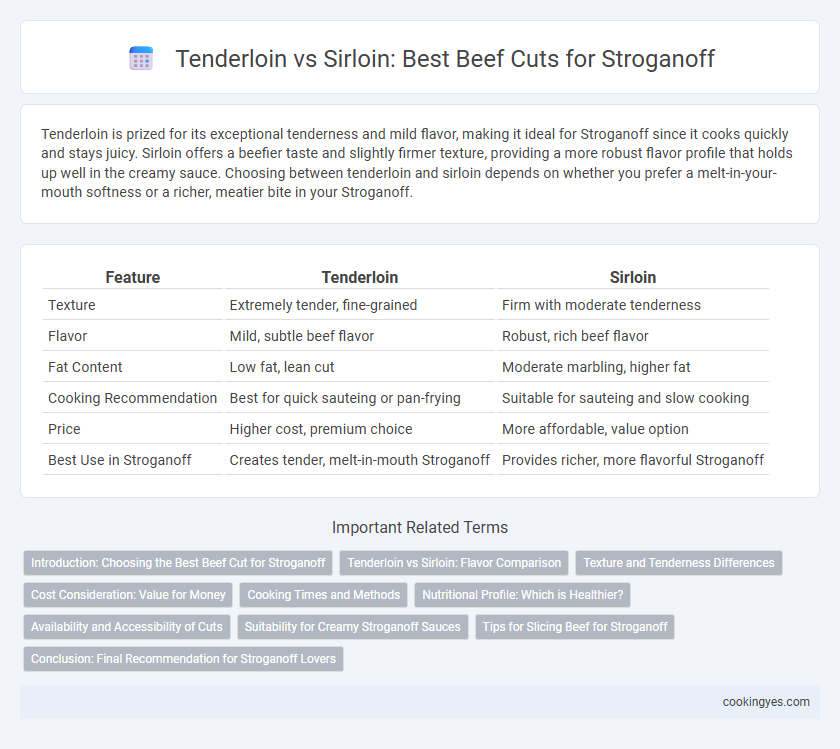Tenderloin is prized for its exceptional tenderness and mild flavor, making it ideal for Stroganoff since it cooks quickly and stays juicy. Sirloin offers a beefier taste and slightly firmer texture, providing a more robust flavor profile that holds up well in the creamy sauce. Choosing between tenderloin and sirloin depends on whether you prefer a melt-in-your-mouth softness or a richer, meatier bite in your Stroganoff.
Table of Comparison
| Feature | Tenderloin | Sirloin |
|---|---|---|
| Texture | Extremely tender, fine-grained | Firm with moderate tenderness |
| Flavor | Mild, subtle beef flavor | Robust, rich beef flavor |
| Fat Content | Low fat, lean cut | Moderate marbling, higher fat |
| Cooking Recommendation | Best for quick sauteing or pan-frying | Suitable for sauteing and slow cooking |
| Price | Higher cost, premium choice | More affordable, value option |
| Best Use in Stroganoff | Creates tender, melt-in-mouth Stroganoff | Provides richer, more flavorful Stroganoff |
Introduction: Choosing the Best Beef Cut for Stroganoff
Tenderloin offers unparalleled tenderness and a buttery texture, making it a premium choice for Stroganoff, ideal for those seeking a melt-in-the-mouth experience. Sirloin, while slightly less tender, delivers robust beef flavor and a firmer bite, providing excellent value without compromising taste. Selecting between tenderloin and sirloin ultimately depends on prioritizing tenderness or flavor intensity for the classic Stroganoff dish.
Tenderloin vs Sirloin: Flavor Comparison
Tenderloin offers a buttery, delicate flavor with exceptional tenderness, making it ideal for Stroganoff when a melt-in-the-mouth texture is desired. Sirloin presents a richer, beefier taste with a firmer texture, contributing more robust and pronounced flavor notes to the dish. Choosing between tenderloin and sirloin depends on balancing flavor intensity and tenderness to suit personal preference in Stroganoff preparations.
Texture and Tenderness Differences
Tenderloin offers a remarkably tender texture due to its fine-grained muscle fibers, making it ideal for Stroganoff recipes that prioritize melt-in-the-mouth softness. Sirloin, while still tender, presents a firmer texture with more pronounced beefy flavor, resulting from its slightly denser muscle structure. Choosing tenderloin enhances the dish's luxurious creaminess, whereas sirloin contributes a satisfying chew and richer taste, influencing the overall Stroganoff experience.
Cost Consideration: Value for Money
Sirloin offers a more affordable option for Stroganoff while still delivering tender texture and rich flavor, making it a cost-effective choice for budget-conscious meals. Tenderloin, though more expensive, provides superior tenderness and a melt-in-the-mouth experience that can elevate the dish for special occasions. Balancing price with desired quality helps determine the best value for money when selecting beef cuts for Stroganoff.
Cooking Times and Methods
Tenderloin is ideal for Stroganoff due to its tenderness and quick cooking time, typically requiring only a few minutes to sear over high heat to maintain juiciness. Sirloin, while more affordable and flavorful, benefits from slightly longer cooking and marinating to tenderize, making it suitable for slower sauteing or simmering methods. Choosing tenderloin reduces the risk of overcooking, whereas sirloin demands careful temperature control to avoid toughness.
Nutritional Profile: Which is Healthier?
Tenderloin offers a leaner nutritional profile with lower fat and calorie content, making it a healthier option for Stroganoff when aiming for a diet-conscious meal. Sirloin, while slightly higher in fat, provides more iron and zinc, essential nutrients that support muscle function and immune health. Choosing between tenderloin and sirloin depends on balancing lower fat intake with the need for important minerals in Stroganoff beef cuts.
Availability and Accessibility of Cuts
Tenderloin is less commonly available and often more expensive, making it less accessible for everyday Stroganoff recipes. Sirloin is widely available in most grocery stores and butcher shops, offering greater accessibility for home cooks. Choosing sirloin provides a balance of quality and convenience without compromising the dish's tenderness when sliced thinly.
Suitability for Creamy Stroganoff Sauces
Tenderloin offers a buttery tenderness that absorbs creamy Stroganoff sauces effortlessly, enhancing the dish's smooth texture and rich flavor profile. Sirloin, while slightly firmer, provides a beefier taste and holds up well against the creamy, mushroom-laden sauce without becoming overly soft. Choosing tenderloin ensures a melt-in-the-mouth experience ideal for silky Stroganoff, whereas sirloin delivers a balanced chew that complements the sauce's richness.
Tips for Slicing Beef for Stroganoff
For optimal Stroganoff preparation, tenderloin offers superior tenderness, making thin, uniform slices easier to achieve, which enhances the dish's texture. Sirloin, while more affordable and flavorful, requires careful slicing against the grain to prevent toughness and ensure each bite remains tender. Using a sharp knife and resting the beef before slicing improves precision and helps maintain the meat's juiciness in Stroganoff recipes.
Conclusion: Final Recommendation for Stroganoff Lovers
Tenderloin offers the most tender, melt-in-your-mouth texture ideal for Stroganoff's creamy sauce, making it perfect for those prioritizing tenderness and luxury. Sirloin delivers a more robust beef flavor and slightly firmer texture, providing a better value without sacrificing quality or taste. Stroganoff lovers seeking a balance of flavor and cost-effectiveness should choose sirloin, while those desiring an indulgent, ultra-tender experience will prefer tenderloin.
Tenderloin vs Sirloin for Stroganoff Beef Cut Infographic

 cookingyes.com
cookingyes.com